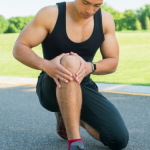 |
What is Physiotherapy Taping? Physiotherapy taping, also known as athletic or kinesiology taping, is a type of therapeutic technique used for rehabilitation and for enhancing sport performance. First, strips of adhesive tape are applied to the skin with the location depending on the area of injury or the goal of the treatment. A physiotherapist can help you apply the tape and teach you how to tape yourself at home as well! Why do people receive Physiotherapy Taping? There are many benefits to using physiotherapy tape, we’ll describe some common applications of taping to help you understand why taping has become…
Read More










